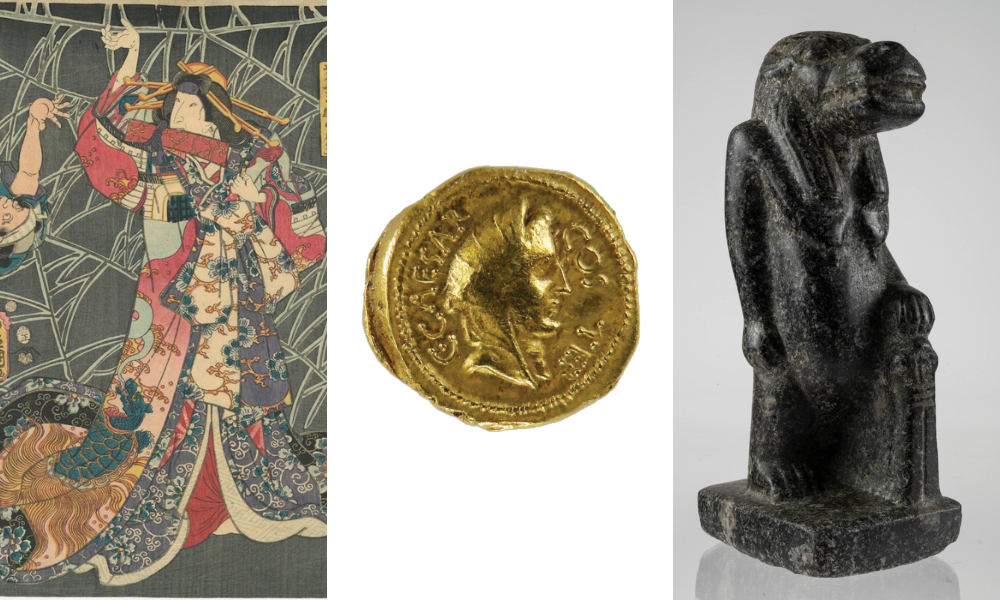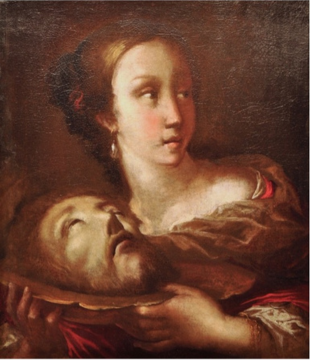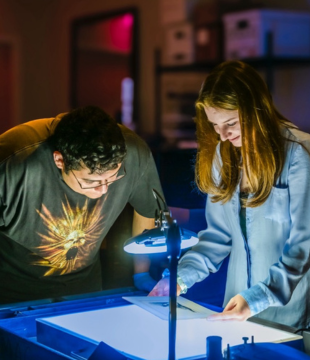A Museum Without Walls
Madison Art Collection launches digital access to its art collection
College of Visual and Performing Arts
James Madison University’s (JMU) Madison Art Collection has just unveiled an innovative new website, bringing unprecedented digital access to its vast collection of cultural treasures. This exciting development marks a major step forward for both JMU and the collection, expanding its mission to preserve and share art and artifacts with audiences on and off campus. Now, anyone with an internet connection can explore centuries of art, history, and heritage from the comfort of their own home.
“The Madison Art Collection is, unfortunately, a well-kept secret of the university,” says Ginny Soenksen, director of the Madison Art Collection. “We are trying to change that.”
The Collection, which includes over 35,000 objects from various cultures, time periods, and mediums, boasts an impressive array of famous artists, including Andy Warhol, Roy Lichtenstein, and Rembrandt. The arts of the ancient world include funerary items from Egypt, rare coins from Greece and Rome, and dozens of Japanese woodblock prints from the early modern period. These objects are made available to the public at the Lisanby Museum, which generates original, student-created exhibitions.
“This isn’t a collection that should languish in obscurity,” Soenksen continued, “It should act as the community resource we know it can be.”
While physical access to objects in the Lisanby Museum is free to all, space constraints limit the number of artwork that can be on view at a time. With a collection so large, it would take around 500 years to exhibit every single object. The Collection will soon move to a larger gallery space, which will allow for more objects to be featured in exhibitions. However, because of a university-wide commitment to accessible engagement, JMU wants to provide digital access to the Collection as well.
“JMU—particularly JMU Libraries and Dean Rubén Graciani of the College of Visual and Performing Arts—has been hugely supportive of our digitization efforts, especially by acquiring The Museum System (TMS),” says Soenksen. “TMS is a collections management software that allows anyone with an internet browser to search through collection information and images. For the first time in the history of the Collection, visitors will be able to see all of the treasures in our storeroom. We will add more information, images, and resources daily, so there will always be something new to discover.”
This includes an 18th-century painting of Salome with the head of John the Baptist by an unknown Italian artist that once hung in the dining room of James Madison’s Montpelier.

Riley Harris, an Art History major and MAC intern, stated, “Software like this is prevalent in a lot of workspaces and parts of the museum industry. It is not something that you can pick up on a whim; it takes practice to understand the program, and it’s great to have that opportunity as an undergraduate before going into the field.”
“TMS is essential to our work at the MAC,” says Dr. Maria Harvey, associate director of MAC. “It allows us to broaden our collaborations across the university. I have been particularly excited to work with students to ensure that our information is accessible and mirrors the field’s best practices. I want to thank all of our students for their hard work in cataloging, transcribing, photographing, and researching over the past year.”
This software, also utilized by prestigious museums such as the British Museum, the Smithsonian Institution, and the Metropolitan Museum of Art, is not typically available to students at an undergraduate or even a graduate level. JMU students will be able to train on this software to increase their professional skills, while those outside the university campus can learn more about the objects. It is the hope of MAC staff that by providing access to local educators and scholars further afield, they can add to MAC’s understanding of the art under its stewardship.

“There is constant development when it comes to our understanding of cultural heritage, material heritage, and history,” says Soenksen. “Object files should be constantly developed as well. We welcome scholars and members of the community to communicate with us if they have expertise related to anything they see in our collection. Broader access means a broader array of perspectives, which is always a good thing when it comes to education.”
This news comes in the wake of many recent initiatives and accomplishments of the MAC. This includes Hanbok Saenghwal: Korean Fashion Then and Now (Fall 2023 – Spring 2024), the first exhibition of Korean art at JMU, and acting as a major lender, the international retrospective exhibition Ben Shahn: On Nonconformity (Fall 2023 – Spring 2024) at the Museo Nacional Centro de Arte Reina Sofía. MAC also secured a loan of artwork and funding to support engagement through the Art Bridges Foundation, as well as acceptance into the 2024 cohort of the Museum Assessment Program operated by the American Alliance of Museums (AAM).
The positive impact of the TMS acquisition has already been felt by positive feedback from faculty and students. “I just had a student come into the Museum and ask where they could find more information on collection objects,” says MAC student assistant Anna Keath Smith. “I was so excited to share the news about online access, and it’s only going to get bigger and better from here on out!”
To learn more about the Madison Art Collection, visit Madison Art Collection. To explore its digitized Collection, visit https://jmu.emuseum.com/collections.
Visitors are welcome to visit the MAC and Lisanby Museum Tuesday through Friday, from 12 – 4 pm during the semester.
Where to find us:
Madison Art Collection and Lisanby Museum, Room 1108, Festival Conference and Student Center, 1301 Carrier Drive, Harrisonburg. Virginia, 22807.
About the Madison Art Collection:
The Madison Art Collection’s (MAC) mission is to serve the academic, local, and global community by researching, collecting, conserving, interpreting and exhibiting tangible and intangible heritage. As the primary visual arts resource on campus, MAC serves the on- and off-campus community through exhibitions, class projects, and special programming. MAC operates in close alignment with the strategic plan of the university, which emphasizes innovation, the advancement of access, and adapting and improving practices in light of the COVID-19 pandemic.
